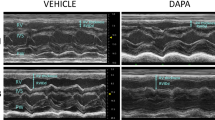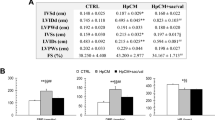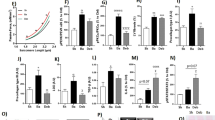Abstract
Controversy exists whether the development of left-ventricular hypertrophy (LVH) is a mechanism able to prevent cardiac dysfunction under conditions of pressure overload. In the present study we re-assessed the long-term effects of attenuating LVH by using l- and d-propranolol, which are equally able to inhibit the development of LVH induced by aortic banding. The aortic arch was banded proximal to the left common carotid artery in 71 CD-1 mice that were then assigned randomly to receive l-propranolol, d-propranolol (both 80 mg/kg per day) or vehicle. Concurrently, sham-operated mice were given l-propranolol, d-propranolol or vehicle. LV dimension and performance were evaluated under isoflurane anaesthesia by cine-magnetic resonance imaging, echocardiography and cardiac catheterization up to 8 weeks after surgery. After 2 weeks of pressure overload, the vehicle-treated banded mice had enhanced LV weight, normal chamber size and increased relative wall thickness (concentric hypertrophy), whereas l-propranolol- or d-propranolol-banded mice showed a markedly blunted hypertrophic response, i.e. normal chamber size and normal relative wall thickness, as well as preserved systolic LV chamber function. After 4 weeks, the vehicle-treated banded mice showed LV enlargement with a reduced relative wall thickness (eccentric remodelling) and a clear-cut deterioration in LV systolic function. In contrast, l-propranolol- or d-propranolol-treated banded mice showed normal chamber size with a normal relative wall thickness and preserved systolic function. A distinct histological feature was that in banded mice, l- or d-propranolol attenuated the development of cardiomyocyte hypertrophy but not the attendant myocardial fibrosis. At the 8-week stage, LV dysfunction was present in propranolol-treated banded mice although it was much less severe than in vehicle-treated banded mice. It is concluded that (i) deterioration of LV systolic performance is delayed if LV hypertrophy is inhibited, (ii) banding-induced deterioration of LV systolic function is associated with LV eccentric remodelling and (iii) the antihypertrophic effect of propranolol is due to a selective action on cardiomyocytes rather than on collagen accumulation




Similar content being viewed by others
Abbreviations
- dP/dt max :
-
maximum rate of change of left-ventricular pressure
- EF:
-
ejection fraction
- FLASH:
-
fast low-angle shot
- LV:
-
left ventricle, left-ventricular
- LVEDD:
-
left-ventricular end-diastolic diameter
- LVEDP:
-
left-ventricular end-diastolic pressure
- LVEDV:
-
left-ventricular end-diastolic volume
- LVESD:
-
left-ventricular end-systolic diameter
- LVESV:
-
left-ventricular end-systolic volume
- LVH:
-
left-ventricular hypertrophy
- LVW:
-
left-ventricular weight
- LVW/TL:
-
left-ventricular weight normalised to tibial length
- LVWS:
-
left-ventricular wall stress
- MR(I):
-
magnetic resonance (imaging)
- PS:
-
left-ventricular peak systolic pressure
- PWTD :
-
posterior wall thickness (diastolic)
- PWTS :
-
posterior wall thickness (systolic)
- SWTD :
-
end-diastolic septal thickness
- SV:
-
stroke volume
- TL:
-
tibial length
- WS:
-
wall stress
References
Bartunek J, Weinberg EO, Tajima M, Rohrbach S, Katz SE, Douglas PS, Lorell BH (2000) Chronic N G-nitro-l-arginine methyl ester-induced hypertension: novel molecular adaptation to systolic load in absence of hypertrophy. Circulation 101:423–429
Esposito G, Rapacciuolo A, Naga Prasad SV, Takaoka H, Thomas SA, Koch WJ, Rockman HA (2002) Genetic alterations that inhibit in vivo pressure-overload hypertrophy prevent cardiac dysfunction despite increased wall stress. Circulation 105:85–92
Hill JA, Karimi M, Kutschke W, Davisson RL, Zimmerman K, Wang Z, Kerber RE, Weiss RM (2000) Cardiac hypertrophy is not a required compensatory response to short-term pressure overload. Circulation 101:2863–2869
Marano G, Palazzesi S, Fadda A, Vergari A, Ferrari AU (2002) Attenuation of aortic banding-induced cardiac hypertrophy by propranolol is independent of β-adrenoceptor blockade. J Hypertens 20:763–769
Meguro T, Hong C, Asai K, Takagi G, McKinsey TA, Olson EN, Vatner SF (1999) Cyclosporine attenuates pressure-overload hypertrophy in mice while enhancing susceptibility to decompensation and heart failure. Circ Res 84:735–740
Nakamura A, Rokosh DG, Paccanaro M, Yee RR, Simpson PC, Grossman W, Foster E (2001) LV systolic performance improves with development of hypertrophy after transverse aortic constriction in mice. Am J Physiol 281:H1104–H1112
Oie E, Bjornerheim R, Clausen OP, Attramadal H (2000) Cyclosporin A inhibits cardiac hypertrophy and enhances cardiac dysfunction during postinfarction failure in rats. Am J Physiol 278:H2115–H2123
Sakata Y, Masuyama T, Yamamoto K, Nishikawa N, Yamamoto H, Kondo H, Ono K, Otsu K, Kuzuya T, Miwa T, Takeda H, Miyamoto E, Hori M (2000) Calcineurin inhibitor attenuates left ventricular hypertrophy, leading to prevention of heart failure in hypertensive rats. Circulation 102:2269–2275
Shimoyama M, Hayashi D, Takimoto E, Zou Y, Oka T, Uozumi H, Kudoh S, Shibasaki F, Yazaki Y, Nagai R, Komuro I (1999) Calcineurin plays a critical role in pressure overload-induced cardiac hypertrophy. Circulation 100:2449–2454
Yin FC, Spurgeon HA, Rakusan K, Weisfeldt ML, Lakatta EG (1982) Use of tibial length to quantify cardiac hypertrophy: application in the aging rat. Am J Physiol 243:H941–H947
Acknowledgements
This work was supported in part by a grant of the Ministry of Health (ICS 030.6/RF00-49)
Author information
Authors and Affiliations
Corresponding author
Rights and permissions
About this article
Cite this article
Marano, G., Palazzesi, S., Vergari, A. et al. Inhibition of left ventricular remodelling preserves chamber systolic function in pressure-overloaded mice. Pflugers Arch - Eur J Physiol 446, 429–436 (2003). https://doi.org/10.1007/s00424-003-1059-2
Received:
Revised:
Accepted:
Published:
Issue Date:
DOI: https://doi.org/10.1007/s00424-003-1059-2




